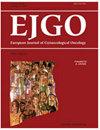妊娠相关乳腺恶性肿瘤多表现为侵袭性乳腺癌
IF 0.5
4区 医学
Q4 OBSTETRICS & GYNECOLOGY
引用次数: 0
摘要
已发表的关于妊娠相关乳腺癌预后的报告存在争议。本研究旨在确定妊娠相关乳腺癌(PABC)的组织病理学特征以及土耳其妇女妊娠和哺乳期乳腺癌患者的预后。该研究回顾性分析了1989年1月至2021年3月期间接受手术诊断为妊娠相关乳腺恶性肿瘤的29例患者。获得人口学和病理资料,以评估患者的临床病理和预后特征。年龄中位数为36岁(范围:26-42岁)。29例乳腺癌患者中,孕期确诊13例(44.8%),哺乳期确诊16例(55.2%)。大多数患者临床肿瘤分期(cT) cT2-3 (n = 20, 69%),临床淋巴结(cN)阳性15例(N1和N2, 51.7%)。大多数(n = 19, 65.5%)为浸润性导管癌,Ki-67评分较高(>20%)。与妊娠相关的乳腺癌患者相比,哺乳期乳腺癌患者更有可能有乳腺癌家族史(44%比8%,p = 0.04)。值得注意的是,症状持续时间≥6个月且呈现cT3-4或cN(+)疾病与较差的无病生存和疾病特异性生存相关。然而,妊娠期和哺乳期相关乳腺癌患者的预后没有发现差异。PABC主要表现为侵袭性肿瘤分子亚型,Ki-67评分较高,晚期预后较差,可能是由于诊断延迟所致。因此,及时的早期诊断和意识到这种疾病可能会提高生存率。本文章由计算机程序翻译,如有差异,请以英文原文为准。
Pregnancy-associated breast malignancy mostly presents with an aggressive type of breast cancer
Published reports on the prognosis of pregnancy-associated breast cancer are controversial. This study aims to determine the histopathological features of pregnancy-associated breast carcinoma (PABC) and the outcomes of patients with breast cancer during pregnancy and lactation among Turkish women. The study retrospectively analyzed 29 patients diagnosed with pregnancy-associated breast malignancies who underwent surgery between January 1989 and March 2021. Demographic and pathological data were obtained to evaluate the clinicopathological and prognostic characteristics of the patients. The median age was 36 years (range: 26–42 years). Of the 29 patients with breast cancer, 13 (44.8%) were diagnosed during pregnancy, and the remaining 16 (55.2%) were diagnosed during lactation. Most patients had clinical tumor stage (cT) cT2–3 (n = 20, 69%) disease, and 15 patients had clinically node (cN)-positive disease (N1 and N2, 51.7%). The majority (n = 19, 65.5%) had invasive ductal carcinoma with high Ki-67 scores (>20%). Patients with lactation-associated breast cancer were more likely to have a family history of breast cancer (44% vs. 8%, p = 0.04) than those with pregnancy-associated breast cancer. Notably, symptom duration ≥6 months and presenting with cT3–4 or cN(+) disease were associated with poor disease-free and disease-specific survival. However, no difference could be found in outcome among patients with pregnancy- and lactation-associated breast cancer. PABC mostly presents with aggressive tumor molecular subtypes with high Ki-67 scores and more advanced stages associated with poor outcome, possibly due to delayed diagnosis. Therefore, prompt early diagnosis and awareness of this disease might improve survival.
求助全文
通过发布文献求助,成功后即可免费获取论文全文。
去求助
来源期刊
自引率
25.00%
发文量
58
审稿时长
1 months
期刊介绍:
EJGO is dedicated to publishing editorial articles in the Distinguished Expert Series and original research papers, case reports, letters to the Editor, book reviews, and newsletters. The Journal was founded in 1980 the second gynaecologic oncology hyperspecialization Journal in the world. Its aim is the diffusion of scientific, clinical and practical progress, and knowledge in female neoplastic diseases in an interdisciplinary approach among gynaecologists, oncologists, radiotherapists, surgeons, chemotherapists, pathologists, epidemiologists, and so on.

 求助内容:
求助内容: 应助结果提醒方式:
应助结果提醒方式:


